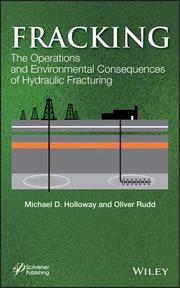-
Zusatztext
-
This book presents both sides of a very controversial subject in today's media: induced hydraulic fracturing, or "fracking." It covers the technology and methods used in hydraulic fracturing in easy-to-understand language, for the engineer and layperson alike, presenting the environmental effects of hydraulic fracturing.
-
-
Kurztext
-
This book explores the history, techniques, and materials used in the practice of induced hydraulic fracturing, one of today's hottest topics, for the production of natural gas, while examining the environmental and economic impact. You can't squeeze blood from a turnip, but you can release trapped natural gas from rock. At least that is what is being accomplished now throughout North America. Natural gas that is primarily methane has been proven to be an excellent fuel source. It can be safely burned to create heat to power engines, boilers in factories and homes as well as powering turbines for generating electricity. Projections on natural gas volumes trapped underground suggest a nearly inexhaustible supply of this product. Yet with such abundance comes controversy. A popular and economical technique relies on the gas from subterranean sources and requires fracturing rock bed. This process is actually carried out naturally every day with water or magma. Magma may flow into rock beds superheating water to generate steam. The resulting pressure of the expanding water molecules can be so great, it can lift and separate thousands of tons of rock deep beneath the Earth's surface. This same practice can be carried out artificially (induced) using high-powered pumps and various liquid compounds. This technique combined with new horizontal directional drilling machines have enabled the harvest and distribution of natural gas. But at what cost? Does this practice contribute to greenhouse gas? Does it create earthquakes? Does it contaminate the groundwater supply? These are important issues surrounding hydraulic fracturing, and they are covered here in detail. This groundbreaking new volume: * Presents both sides of a very controversial subject-induced hydraulic fracturing, or "fracking" * Covers the technology and methods used in hydraulic fracturing in easy-to-understand language, for the engineer and layperson alike * Covers in detail the operations of fracking, including drilling, well completion, blowouts, and other technical aspects * Examines in detail the most common objections to drilling operations, such as noise, the possibility of earthquakes, groundwater contamination, and others
-
-
Autorenportrait
- InhaltsangabePreface xi Introduction xiii 1 Environmental Impact - Reality and Myth and Nero Did Not Fiddle While Rome Burned 1 2 Production Development 5 3 Fractures: Their Orientation and Length 11 4 Casing and Cementing 15 5 PreDrill Assessments 19 6 Well Construction 23 7 Well Operations 29 8 Failure and Contamination Reduction 43 9 Frack Fluids and Composition 49 10 So Where Do the Frack Fluids Go? 61 11 Common Objections to Drilling Operations 63 12 Air Emissions Controls 87 Review Permits 99 13 Chemicals and Products on Locations 101 14 Public Perception, the Media, and the Facts 125 14.1 Regulation or Policy Topics: Media Coverage and Public Perception 131 15 Notes from the Field 139 Appendix A 157 Appendix B 353 References 354 Bibliography 357 Index 359
Detailansicht
Induced Hydraulic Fracturing
Energy Sustainability
ISBN/EAN: 9781118496329
Umbreit-Nr.: 4622758
Sprache:
Englisch
Umfang: 392 S.
Format in cm: 2.5 x 24.3 x 16
Einband:
gebundenes Buch
Erschienen am 28.06.2013
Auflage: 1/2013


